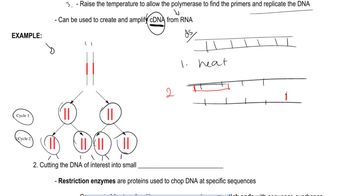Table of contents
- 1. Introduction to Genetics51m
- 2. Mendel's Laws of Inheritance3h 37m
- 3. Extensions to Mendelian Inheritance2h 41m
- 4. Genetic Mapping and Linkage2h 28m
- 5. Genetics of Bacteria and Viruses1h 21m
- 6. Chromosomal Variation1h 48m
- 7. DNA and Chromosome Structure56m
- 8. DNA Replication1h 10m
- 9. Mitosis and Meiosis1h 34m
- 10. Transcription1h 0m
- 11. Translation58m
- 12. Gene Regulation in Prokaryotes1h 19m
- 13. Gene Regulation in Eukaryotes44m
- 14. Genetic Control of Development44m
- 15. Genomes and Genomics1h 50m
- 16. Transposable Elements47m
- 17. Mutation, Repair, and Recombination1h 6m
- 18. Molecular Genetic Tools19m
- 19. Cancer Genetics29m
- 20. Quantitative Genetics1h 26m
- 21. Population Genetics50m
- 22. Evolutionary Genetics29m
18. Molecular Genetic Tools
Genetic Cloning
Problem 34b
Textbook Question
Textbook QuestionThere are a variety of circumstances under which rapid results using multiple markers in PCR amplifications are highly desired, such as in forensics, pathogen analysis, or detection of genetically modified organisms. In multiplex PCR, multiple sets of primers are used, often with less success than when applied to PCR as individual sets. Numerous studies have been conducted to optimize procedures, but each has described the process as time consuming and often unsuccessful. Considering the information given in Problem 30, why should multiplex PCR be any different than single primer set PCR in terms of dependability and ease of optimization?
 Verified Solution
Verified SolutionThis video solution was recommended by our tutors as helpful for the problem above
Video duration:
1mPlay a video:
197
views
Was this helpful?
Related Videos
Related Practice

